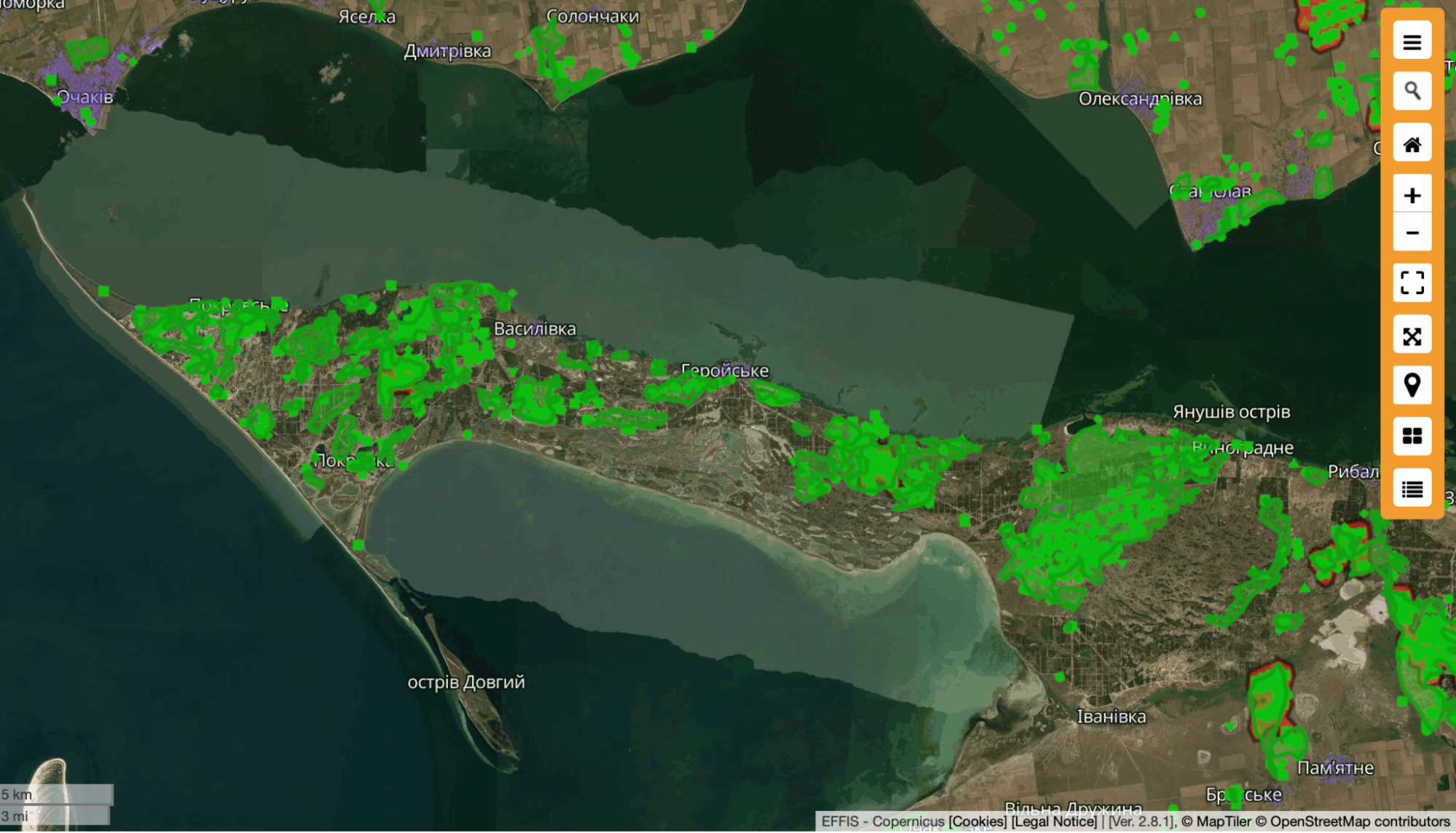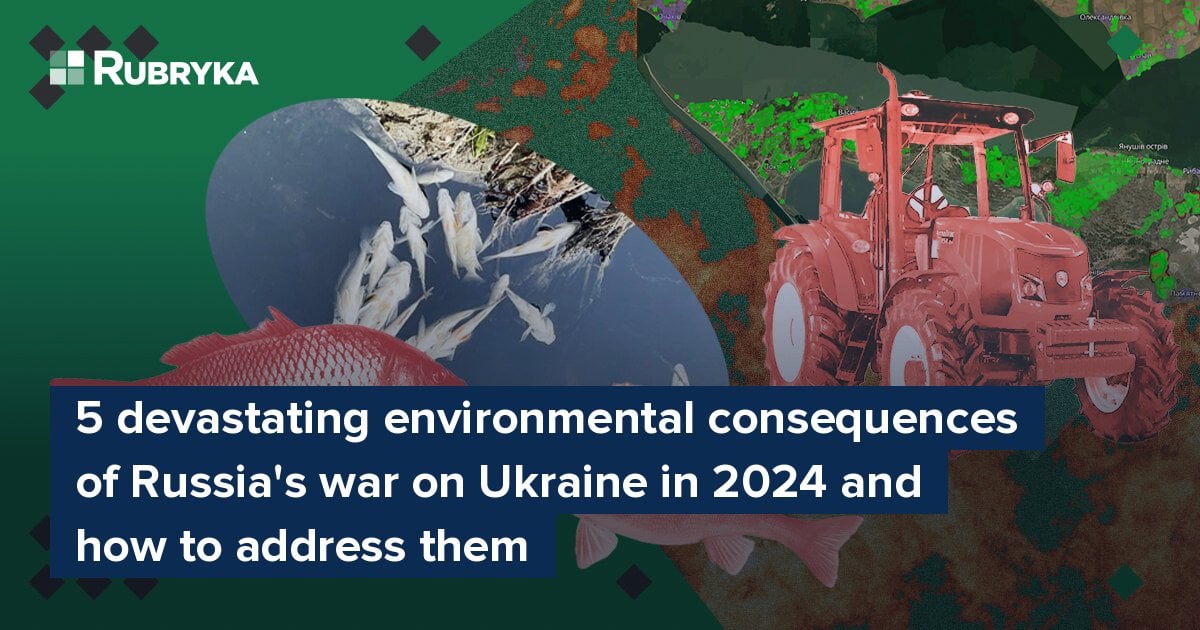
What is the problem?
As of November 2024, Ukraine's Prosecutor General's Office has initiated 222 criminal cases related to Russian war crimes impacting the environment. Of these, 14 have been classified as ecocide.
The estimated environmental damage exceeds three trillion hryvnias (about $71,665,500,000), according to the State Ecological Inspectorate of Ukraine. These figures represent documented losses and remain approximate. At the start of 2024, the estimated damage was significantly lower— UAH 2.2 trillion compared to the current figure of UAH 3.1 trillion. This article examines Russia's actions in 2024 that caused the most severe environmental consequences in Ukraine.
The "black" river and Tons of dead fish — in 2024, the Russians committed a new terrorist attack
At the start of 2024, the damage from pollution and contamination of water resources, including sea waters, was estimated at 82.2 billion hryvnias (about $1,963,634,700). By the end of the year, this figure had risen to 84.65 billion (about $2,022,161,525).
A significant portion of these losses resulted from pollution of the Seim and Desna Rivers. This event, regarded as yet another act of terrorism by Russia, caused damage estimated at over UAH 500,000,000 (about $11,940,000). The incident drew widespread attention in the media—and for good reason. By late August, the water in the affected river had turned dark, almost black. Mass deaths of fish and other aquatic organisms were reported, accompanied by a pervasive stench that filled the air.

Photo: The State Agency of Melioration and Fisheries of Ukraine
Investigations later revealed that the most likely cause of the pollution was runoff from the settling tanks of a sugar refinery in the Russian city of Tiotkino, located near the border with Ukraine. In response, criminal proceedings were initiated to address the incident of river contamination.
What is the solution?
Environmentalists quickly pointed out that nature has the ability to self-purify, and the river's flow would gradually dilute the pollution. This prediction proved accurate. Within a few weeks of the incident, the water quality returned to normal and has remained stable ever since.

Illustrative photo: desna-buvr.gov.ua
However, this improvement only applies to the quality of the water flowing through the river. Restoring the entire ecosystem will take much longer. For instance, the river must see the return of live fish, along with other organisms like invertebrates, mollusks, and insects. According to Serhii Afanasyev, director of the Institute of Hydrobiology at the National Academy of Sciences of Ukraine, this recovery process could take two to three years.
The scale of the pollution was unprecedented, making this incident a significant case study for scientific research on ecosystem restoration in Ukraine.
Fires and heavy machinery in the protected area
The occupied Ivory Coast of Sviatoslav National Nature Park burned down almost completely
Fire damage constitutes the largest share of environmental consequences resulting from the war. These fires can stem from various causes, including intentional arson originating from Russian territory, missile strikes, and explosions.
One of the most devastating incidents was the burning of the Kinburn Peninsula, part of the Ivory Coast of Sviatoslav National Nature Park. This area is also included within the UNESCO Black Sea Biosphere Reserve. According to a study on the environmental impacts of the war, conducted by Top Lead in collaboration with the Ministry of Environmental Protection, 96% of the National Park's land area was destroyed by the fires.

Fires recorded on the Kinburn Peninsula from January 1 to December 11, 2024. Source: EFFIS
A major loss after the liberation of the peninsula may be the burnt Pokrovske Orchid Field, the largest orchid field in all of Europe. It has probably been destroyed, as have thousands of hectares of steppes. And it is not only fires that are causing damage — the Russians are deploying heavy equipment on the island, moving through valuable natural areas where it is only allowed to walk, using heavy tracked vehicles. This leads to the trampling of rare plants on the island. In addition, the entire territory of the peninsula is considered potentially mined.
Another consequence of the occupation is the destruction of biodiversity on the peninsula. According to Kostiantyn Redinov, a senior researcher and acting director of the Regional Landscape Park "Kinburn Spit", two factors should be distinguished in the impact of hostilities on birds. They are at risk of death from fires, shooting, contamination with fuels and lubricants, etc. The second negative impact factor is the destruction of nesting sites, as birds have lost their homes in a significant part of Kinburn. Unfortunately, the negative effects of these two factors are interconnected and reinforce each other.
What is the solution?
Pavlo Kholodniak, deputy director of the Ivory Coast of Sviatoslav National Nature Park, stated that the primary efforts after the liberation of the Kinburn Peninsula will focus on demining the area and conducting a comprehensive study of the ecosystem. Discussions about restoring the ecosystems can only begin once the territory is cleared of explosives.
Only after demining will it be possible to clean up the burnt areas and plan measures to revive the peninsula's unique natural environment. "Our task is to assist nature in its recovery. However, the issue of explosive contamination will persist for many years, and we cannot tackle it alone," Kholodnyak emphasized.
What cannot be restored, but can only be compensated for
Air contamination
By the end of 2023, damage to atmospheric air from pollution caused by the burning of petroleum products was estimated at nearly UAH 47 billion (around $1.12 billion). Today, that figure has nearly tripled, reaching over 138 billion hryvnias (around $3.29 billion), according to EcoZagroza. Overall, the total damage to the atmosphere—including the effects of forest fires, their destruction, and pollutant emissions—amounts to UAH 756 billion ($3.29 billion).
For instance, at the end of June this year, an enemy attack triggered a large-scale fire at a warehouse in the Odesa region. The fire covered an area of over 3,000 square meters, releasing approximately 240,000 tons of pollutants into the air. The resulting damage, calculated in monetary terms, exceeded 720,000 hryvnias (around $17,225).
What is the solution?
Restoring polluted air is not possible, but its negative impact can be mitigated by reducing emissions where feasible. One potential solution is the adoption of renewable energy sources, which can replace fossil fuels and significantly lower carbon emissions.
As part of its green reconstruction efforts, Ukraine is focusing on increasing the share of renewable energy. This goal is outlined in the Strategy for Low-Carbon Development of Ukraine until 2050, which was created in 2018. At the COP-29 climate conference in November, a revised version of the strategy was presented, updated to address current challenges. Although a public discussion of the strategy's details has not yet occurred, the Ministry of Environmental Protection plans to hold one. The updated strategy is expected to support further transformation of the domestic energy market and its integration with the European market, particularly in terms of implementing emissions trading and applying the European Carbon Border Adjustment Mechanism (CBAM).
Forest fires
It is impossible to determine the exact number of hectares of forest burned due to hostilities on the EcoZagroza portal, as no such data is available there. According to preliminary estimates by the UWEC Work Group, approximately 104,000 hectares of forest have been damaged by the war. This figure includes forests that were both directly destroyed by hostilities and otherwise affected across Ukraine.
The State Forestry Agency of Ukraine reports lower numbers—900 hectares of completely destroyed forests that can be examined on-site, specifically in areas of Ukraine that are safe and under control. While these figures are challenging to visualize on a national scale, they can be better understood by looking at specific examples, such as the Holy Mountains National Nature Park in the Donetsk region.

Fire in the Holy Mountains National Nature Park of Donetsk Region
Military operations in the Holy Mountains National Nature Park have resulted in the loss of around 80% of the forested area. Approximately 9,500 hectares of the park's forest have been destroyed by fire, while another 10,000 hectares still require examination and demining. The loss of such a vast amount of forest is already impacting the local climate. Residents report stronger winds, hotter summers, and colder winters as a result of these environmental changes.
What is the solution?
In the summer, Rubryka visited the Holy Mountains National Park and witnessed the efforts of the park staff, who were using their own resources to extinguish a fire in a potentially mined forest. In an attempt to preserve the remaining forest, the staff, at great personal risk, were working to localize the fire with their own equipment. Meanwhile, the process of demining the area is gradually underway to allow for safer fire prevention. However, this demining process is expected to take a long time to complete.

Tractors are used in firefighting to create mineralized strips that prevent the fire from spreading
Restoration efforts for the forests have already begun, even in communities located close to the front line. The areas where the forests were burned will first undergo demining, followed by the planting of new trees to restore the original landscape. This initiative aims to revive the natural environment and preserve the local climate and ecosystem that existed before the war.
Conversion of occupied reserves into landfills and reduction of the area of protected territories
In August, it was reported that the Russian military had established camps within the Stone Graves nature reserve, located near the village of Nazarivka in the Mykolaivka region of the Mariupol district. Considering the nature of the base, which included a training strip and the use of various military equipment, it can be concluded that the Stone Graves reserve has been effectively destroyed. According to Petro Andriushchenko, an advisor to the mayor of Mariupol, this marks the second reserve to be destroyed by Russian forces in the district, with the first being the Meotyda reserve.
These are not the only instances of nature reserves being destroyed. A study published this year by Crimea SOS reveals that many nature reserves, established before the occupation, were re-designated with smaller areas. In total, over 14,000 hectares were removed from the nature reserve fund. Some reserves lost their protected status, while others had their status downgraded. One of the most notable examples is the Kazantip Nature Reserve, where the occupying authorities halved the area. On the remaining land, a glamping site was built, actively marketed as a seaside vacation spot. The Yalta Mountain Forest Reserve also saw a reduction in its area.
According to Olesia Petrovych, a senior biodiversity protection expert at the Reform and Restoration Group of Ukraine's Ministry of Nature, 20% of all nature reserves in Ukraine have been affected by the fighting. In an interview with the Lithuanian newspaper Delfi, she stated:
"If we include internationally important areas, such as those included in the Emerald Network, it would amount to about 3 million hectares—half of the country."
What is the solution?
Restoring the destroyed nature reserves will certainly take time. However, their loss can be compensated by establishing new nature reserves to meet the obligations set by international agreements aimed at increasing protected areas.
Regarding Crimea, the decisions made by the occupying authorities to create nature reserves are illegitimate and hold no legal significance for Ukraine. Nonetheless, the areas designated as nature reserves do possess natural value and should be preserved. After the liberation of Crimea, any changes to the boundaries of nature reserves made by the self-proclaimed authorities will have no legal standing. Nevertheless, these areas will need to be restored to their original state.
Authors: Viktoria Hubareva and Justė Ancevičiūtė







